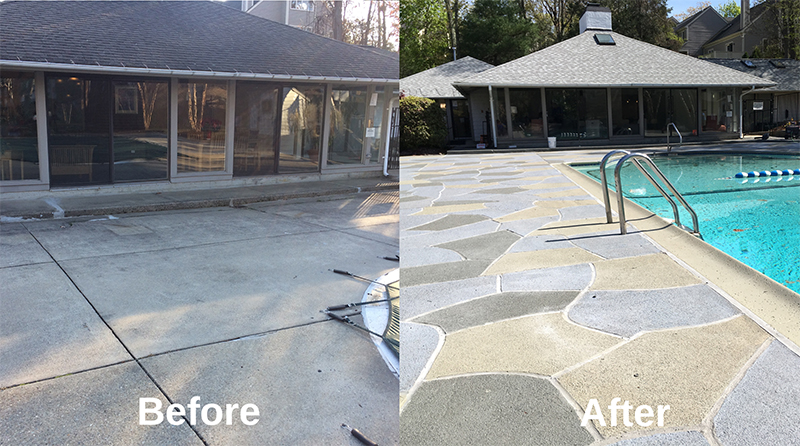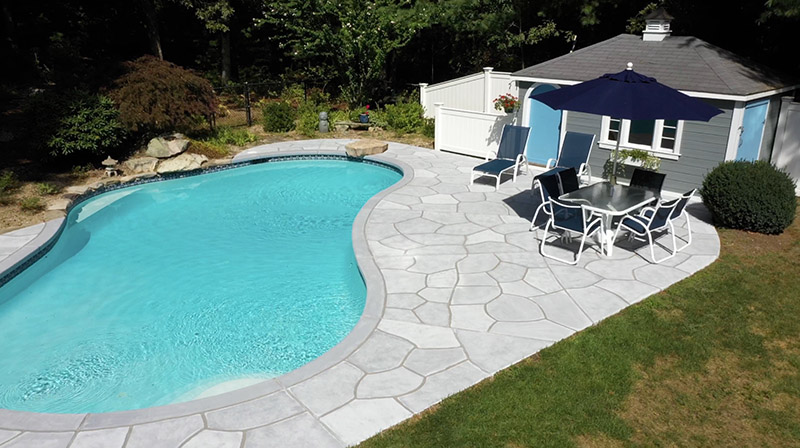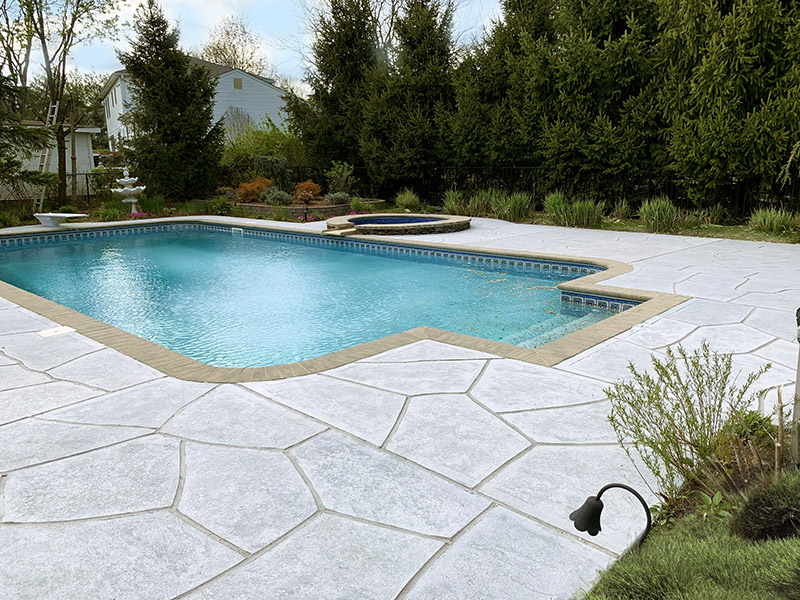

Northborough, MA With warmer weather arriving in the not too distant future (one hopes!), many residential management firms and commercial property owners are planning for repairs that they may have put off “just one more year.” At multi-family residential properties across New England where outdoor concrete slabs have fallen into disrepair, the question might be whether it makes more sense do demo the existing slab or try to salvage it.
RenuKrete has developed a patented, proprietary technology that can turn old, stained and damaged concrete slabs into newly restored surfaces that capture the look of flagstones, slate or tile. RenuKrete’s Engineered Concrete Flooring (ECF) process combines old world sculpting craftsmanship with modern concrete technology to achieve impressive results.

Finding the best option for concrete deck restoration
Freeze and thaw cycles over many New England winters can take their toll on concrete surfaces of all kinds. Particularly those with direct exposure to the elements, such as pool decks, patios and walkways; but also inside where road salts that get tracked in can stain and cause spalling. For residential management firms with pools on their properties, and with concrete pool decks that have become eyesores and a liability concern, there are several options available when it comes to tackling a cracked and heaved deck that’s become a hazard.
Concrete stamping and overlays: One popular option that’s more suitable for applications down South than up North is stamped concrete overlays, sometimes referred to “cememtitious overlays.” These surface treatments, which are essentially thin layers of cement (an eighth of an inch to a quarter inch) sometimes reinforced with polymers, are troweled onto the existing concrete surface. While attractive and versatile, after just a few years in extreme New England weather they can begin to pop off, chip and then peel, leaving the property owner back at square one–with a chipped surface that’s a trip hazard for kids and others lounging around the pool.

Concrete pool deck demolition: Starting over is always an alternative, but the costs of demolition are high not only to budgets but to the environment. And ripping up a deck and pouring new concrete around a pool is not the same thing as tearing up an old sidewalk in front of a house. That’s because the stability of the ground on the turf side of the concrete deck is much greater than on the pool side, meaning demolition can pose significant risks to the integrity of the pool’s walls and seams.
The benefits of restoring the concrete rather than ripping it out and replacing it are manifold. For one, the costs are significantly less when compared to breaking apart the concrete, digging it out and then hauling it away. Furthermore, besides the risks inherent in breaking up and then removing the old concrete, chances are the contractor doing the demo work has little idea of what lies beneath the concrete—like pipes, for instance. Pipes are no match for an errant backhoe bucket or pneumatic jackhammer with a drill bit.


RenuKrete ECF takes a different approach to concrete deck restoration
The RenuKrete ECF process begins by making repairs to the existing concrete pool deck. Even decks that are fractured with cracks and uneven expansion joints can be made to look new as if the wear and tear never existed. By using ECF’s cutting-edge technology, technicians use skill and craftsmanship to sculpt a distinctive natural stone installation design right into the existing concrete. The end results is a concrete pool deck that takes on a totally different characteristic and looks like a new stone installation.
For residential property managers, one of the key benefits of the new decks is the increased appeal they hold for tenants, leasing agents and their clients seeking apartments. Residents take pride in the end result and the pool area becomes a definite attraction for them and their guests.
Bringing a design aesthetic to concrete flooring in commercial spaces
RenuKrete’s technology isn’t limited to outdoors. The company has similarly employed its expertise to existing commercial spaces such as food courts, warehouses, auto showrooms and service areas, lobbies, office hallways, and houses of worship, in the process saving many of its clients’ money.


“In existing commercial spaces where a new tenant might be moving in or renovations to the interior are being made, choosing a floor covering might be among the biggest costs in the property owner’s budget,” said RenuKrete founder, Alex Lorenz. “Like any other undertaking where worker time, materials and budget can come into conflict, anywhere that a cost estimator can save money is a good thing.”
In the vast majority of modern commercial buildings, concrete floors are required to be used on all floors due to the improved fire rating, strength and longevity of concrete compared to other materials. In addition, horizontal concrete is typically used in basement or first floor slab installations of residential and mixed-use buildings all over the world. Rather than covering up these concrete slabs with expensive floor coverings that can run into the tens of thousands of dollars, Lorenz’ company can reveal concrete’s true decorative possibilities in the existing slab. For property managers this is important, because when it comes to attracting new tenants and making existing tenants proud to call a building home, curb appeal means a lot.